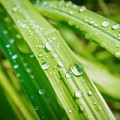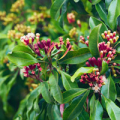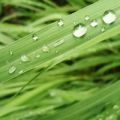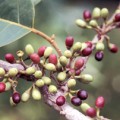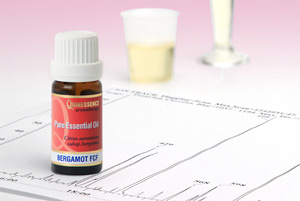The Most Brilliant Article About Patchouli Essential Oil You’ll Ever Read
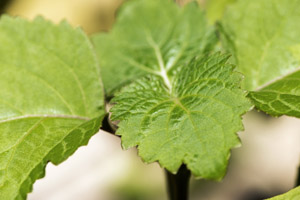 Patchouli essential oil (Pogostemon cablin) is unmistakable, and for those of a certain generation its sweet earthy aroma will often trigger happy memories of the 1960’s and early 1970’s.
Patchouli essential oil (Pogostemon cablin) is unmistakable, and for those of a certain generation its sweet earthy aroma will often trigger happy memories of the 1960’s and early 1970’s.
Adopted by the counterculture that began in the USA and quickly swept the western world, patchouli will be forever associated with hippies, psychedelia, Hare Krishna and marijuana; although not necessarily all of those or in that order!
However, this was not the first time in history that the mysterious scent of patchouli had been held in great esteem. Since ancient times the leaves of this fragrant plant have been used throughout Asia and the Far East as a deodorant, an ingredient for incense, and as an effective insect repellent. Arabs and Persians used layers of crushed patchouli leaves to protect their precious hand-made carpets from moths and insects over a thousand years ago.
Exquisite Indian shawls, fabrics and garments were likewise sprinkled with the leaves, and patchouli was even used as an ingredient in Indian ink. Known as ‘guang huo-xiang’ in ancient China, patchouli was used to perfume the ink for their scrolls too.
Badge of quality
In the early 1800’s, merchants from India, China and the Middle East began transporting large quantities of these expensive carpets and textiles to Europe, where traders learned to recognise the Kashmir shawls and other Indian items as genuine by the distinctive aroma the crushed patchouli leaves had imparted. The mysterious and exotic fragrance of these highly sought after articles quickly became a badge of quality for customers too, though at the time nobody knew where the fragrance originated.
During the 1850’s, French manufacturers discovered the source of the aroma and began importing patchouli leaves to fragrance their own shawls which were then passed off as genuine Indian produce. Soon afterwards, this practice spread to the textile mills of northern Britain, and genuine English ‘Cashmere’ was born!
General description
Belonging to the Lamiaceae family, Pogostemon cablin is a bushy, herbaceous perennial shrub that reaches up to 1.5 metres in height with erect quadrangular stems and aromatic leaves that are often quite large for the size of the plant. Depending on the cultivar, the broadly ovate coarsely serrated leaves grow 5-10 cm in length and 2.5-8 cm wide, and are the source of the essential oil.
Patchouli grows in China, Brazil, India, Indonesia, Madagascar, Malaysia, Philippines, Russia, Seychelles, Taiwan and Vietnam. Despite oil being produced in most of these countries, the finest oil producing areas are confined to Sumatra and Aceh in Indonesia and Mahé in the Seychelles.
Traditional uses
In the Philippines and Malaysia crushed leaves and roots were infused and applied to arthritic and rheumatic joints, and used for painful menstrual cramps. A decoction of leaves was taken orally to treat asthma, coughs, colds and painful urination, whilst a poultice of leaves would be used to treat headaches and boils. Traditional Indian and Chinese medicine recommended patchouli to treat conditions such as abdominal pain, bad breath, colds, diarrhoea, dysentery, flu, fevers, headaches, nausea and vomiting.
Due to its strong fixative properties, unique aroma, and the fact there is no synthetic equivalent, patchouli is irreplaceable in the perfumery industry where it is used to create oriental bases, Fougeres and Chypres. It is also used widely in air fresheners, soft and alcoholic drinks, deodorants, laundry detergents, skin care and soaps.
Harvesting and extraction
Patchouli is often grown on small plots in remote areas where harvesting is usually done by hand using just scissors or knives. After cutting, the leaves are sun, or preferably shade dried on bamboo racks for about 3 days since distilling fresh leaves produces poor quality oil. Finally, the leaves are either distilled on site in a rudimentary fashion using direct-fired field stills, or baled and transported to a modern distillery for processing.
Steam distillation yields a dark orange-brown essential oil with a unique and complex aroma. A good quality patchouli oil should be rich, sweet herbaceous, aromatic spicy with earthy, root-like undertones. Freshly distilled patchouli has musty dry notes that are replaced by a fruity or wine-like top note after maturing.
Benefits of patchouli essential oil
Patchouli excels in skin care where it soothes, rejuvenates, moisturises and tones a diverse range of problem skin-type conditions such as acne, athletes foot, chapped & cracked skin, cellulite, dandruff, dermatitis, eczema, fungal infections, scars, thread veins, wounds and wrinkles.
It works effectively on the emotional system too, helping to stabilize and ground negative emotions such as anxiety, excessive mental activity, lack of confidence, insecurity and mood swings. It acts as a stimulant and tonic to nervous system which can be helpful with stress and general burn-out.
Classed as a base note, patchouli essential oil blends easily with many others such as bergamot, cedarwood atlas & virginian, clary sage, clove bud, frankincense, geranium, grapefruit, lavender, lemon, lemongrass, lime, litsea cubeba, mandarin, myrrh, neroli, orange, petitgrain, pine, rose, sandalwood, tea tree, vetiver, ylang ylang.
Copyright © Quinessence Aromatherapy Ltd 2020.

